

Dummy Caterpillar Instructions. Instructions for participants BH. Using Your Hair to Understand Descriptive Statistics. This page is authored by Christopher Malone and Tisha Hooks from the Department of Mathematics and Statistics at Winona State University.

Author Profile This activity has been undergone anonymous peer review. This activity was anonymously reviewed by educators with appropriate statistics background according to the CAUSE review criteria for its pedagogic collection. This page first made public: May 17, 2007 This material is replicated on a number of sites as part of the SERC Pedagogic Service Project. Riparian Review - Stream Side Science. Time Frame 1 class periods of 70 minutes each Summary In this exercise, students will identify and observe biotic factors in a riparian ecosystem, which is the green strip of vegetation alongside a waterbody; they will measure the types of vegetation at the waters edge, the function of plants as ground cover and canopy cover, and observe the wildlife in the area.

Materials. Water on the Web. Modeling Water Quality. Credits Cindy Hagley, Rich Axler and George Host Goals This exercise has three primary goals: To teach students the basics of interpreting RUSS temperature and oxygen profile data To introduce students to Geographic Information Systems (GIS), particularly with respect to interpreting maps To have students link the GIS information with a model of phosphorus and sediment loadings, and interpret these loadings in light of results from goals 1 and 2.
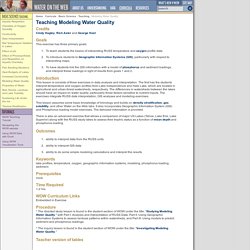
Introduction This lesson is consists of three exercises in data analysis and interpretation. The first has the students interpret temperature and oxygen profiles from Lake Independence and Hale Lake, which are located in agricultural and urban-forest watersheds, respectively. The differences in watersheds between the lakes should have an impact on water quality, particularly those factors sensitive to nutrient inputs. The Biology Place. Primary Productivity Primary productivity is a term used to describe the rate at which plants and other photosynthetic organisms produce organic compounds in an ecosystem.
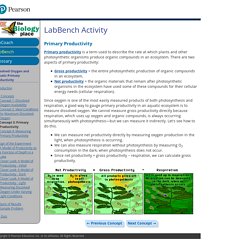
There are two aspects of primary productivity: GPP/NPP Virtual Lab - Teaching AP® Science. I don’t always have time for students to do a lab.

Every day is precious. And, sometimes I don’t have the funds to do a certain lab. Sometimes, I find a video clip instead to help them learn a concept. Recently, however, I’ve started creating my own mini videos. Primary Productivity, Grass - Student - The Environmental Literacy Council. Claycaterpillarproject. Moving from forested habitats to urban centers, the abundance and species richness of native birds decreases (Chase and Walsh 2006).
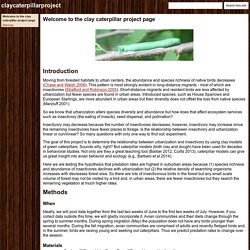
This pattern is most strongly evident in long-distance migrants - most of which are insectivores (Stratford and Robinson 2005). Short-distance migrants and resident birds are less affected by urbanization but fewer species are found in urban areas. Introduced species, such as House Sparrows and European Starlings, are more abundant in urban areas but their diversity does not offset the loss from native species (Marzluff 2001). Experiment #12 from Investigating Environmental Science through Inquiry. Recommended for Middle School through High School.
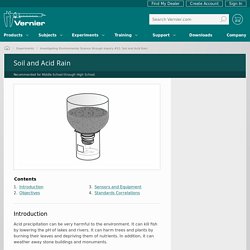
Introduction Acid precipitation can be very harmful to the environment. It can kill fish by lowering the pH of lakes and rivers. It can harm trees and plants by burning their leaves and depriving them of nutrients. Additional Case Studies: Materials Contributed by Teachers. ICBL: Selected Cases. What are Microplastics? Fs205e. Amazon Fly. Filbert Abercrombie was, and perhaps still is, a biologist from Oxford.

His research was on the distribution of flora and fauna within the Amazon River Basin. The part that he loved most about his work was that he needed to spend months each year exploring and mapping some of the most remote parts of the Basin, following some of the smallest of tributaries. The remoteness of the area and the exploration really appealed to him, satisfying his sense of adventure and curiosity and at the same time giving him a certain sense of peace.
There was only one thing that drove him up the wall...the masses of tiny flies that would forever pester him, getting into his eyes, nose and mouth. It drove him crazy! The Great Oyster Mystery. Teaching Environmental Sustainability: Model My Watershed Teacher Guide 2017-2018. Table of Contents Unit Watershed Subject Environmental Science and Earth Science.

Dg 9780761185000. Chesapeake classrooms teachers guide 2015653c. Teaching Environmental Sustainability: Model My Watershed Teacher Guide 2017-2018. Table of Contents Unit Watershed Subject Environmental Science and Earth Science.
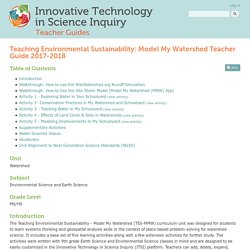
The Great Oyster Mystery. Biofilms and Biodiversity. The Chesapeake Bay is the largest, most productive estuary in the United States, providing habitat for some 2,700 species of plants and animals. The health of the Bay depends on maintaining this high level of biodiversity (the number and variety of species located within an ecosystem). One way to measure biodiversity is to examine biofilm communities. Biofilms are bacterial colonies that form in layers. Resources for Teachers and Students. Looking for information about the Bay? We have resources both students and teachers will find helpful. For Background on Bay Topics: Teachers.
Schoolyard reportcard28aa. Tst1308 10. Tst1402 37. Tst1704 12. Sandbox Succession Project. Environmental Education Field Trip Program. Field Trip Program Opportunities Marsh Critter Discovery Walk (PreK – 2nd grade)60 minutes$8/ studentIntroduce your students to nature and show them that there’s more out there than sharks and poison ivy. Start with a walk down our Salt Marsh Trail, surrounded by waving grasses and shallow water. Hummingbirds at Home. Facebook. Succession and Microclimate. Food Choice in Birds. Claycaterpillarproject. Education Archives - CitizenScience.orgCitizen Science. Education Archives - CitizenScience.orgCitizen Science. Citizen Science — Field Ecology. HerpMapper is a cooperative project, designed to gather and share information about reptile and amphibian observations across the planet. Using HerpMapper, you can create records of your herp observations and keep them all in one place. In turn, your data is made available to HerpMapper Partners – groups who use your recorded observations for research, conservation, and preservation purposes.
2018 Thank You. Free Download: Citizen Science Book Preview. Preview Birds Without Borders with these two sample chapters. This PDF downloads provide a preview of Birds Without Borders. Submission Guidelines - Cornell Lab of Ornithology: BirdSleuth K-12. Nationalgeographic. Field. Writing guidelines. Independent project guidelines. Field Research Project - Jim Baxter. Master Watershed Steward Program. Watershed Education. Watershed Education. Bot 440/540: How to measure per area. Projectsquirrel. Lichens as Bioindicators. The Great Elephant Census Modeling Activity. Chihuahuan Desert Biotic Study. Northwestern University. PLT Presentation August 2013. Northwestern University. iNaturalist Project & Curriculum. Risingtidescience - Ecology Syllabus. FeederWatch - Count Feeder Birds for Science. Bioindicators: Using Organisms to Measure Environmental Impacts.
Macrolife guide final. White Mountain National Forest. School of Ants. Cary Institute of Ecosystem Studies. Cary Institute of Ecosystem Studies. Home : Citizen Science. Questions about Quadrats. Gorongosa: Scientific Inquiry and Data Analysis. Happiness Village - Pandas. Bat%20Count%20Protocol%20and%20Forms. Appalachian Bat Count. PA DCNR - InsectsDisease. Forest Inventory and Analysis National Program. Home - Maine Forest Inventory Growth. 2009%20 %20Willson%20%26%20Gibbons%20 %20Amphibian%20traps%20 %20BOOK%20CHAPTER. FieldScope - National Geographic Society. NestWatch. Crossing Boundaries. Crossing Boundaries. Lesson 1. Boston Schoolyard Initiative. Submission Guidelines. AP Environmental Science Sample Lesson Plans.
Surveying Ant Diversity in Gorongosa National Park. Camera Traps. Building Solitary Bee Nests. Untitled. 2009%20 %20Willson%20%26%20Gibbons%20 %20Amphibian%20traps%20 %20BOOK%20CHAPTER. I-Tree Eco. Great Lakes Worm Watch. Building Solitary Bee Nests. Surveying Ant Diversity in Gorongosa National Park. Submission Guidelines. ConEd Schoolyard Biodiversity Guide. Parking lot diversity activity. Connecting the Dots: From Christmas Cookies to Climate. Takingroot handouts. Endangered Species Chocolate – Indulge In A Cause. Seeds of Change, Inc.